The PWHL unveiled all-new uniforms for its six founding teams on Thursday, after a long process that saw players competing under generic names and logos for the duration of the league's inaugural season.
Bauer — the PWHL's exclusive game and replica home jersey provider — is the sportswear company behind the uniforms. The league also worked closely with creative agency Flower Shop to refine each team's jersey design and branding.
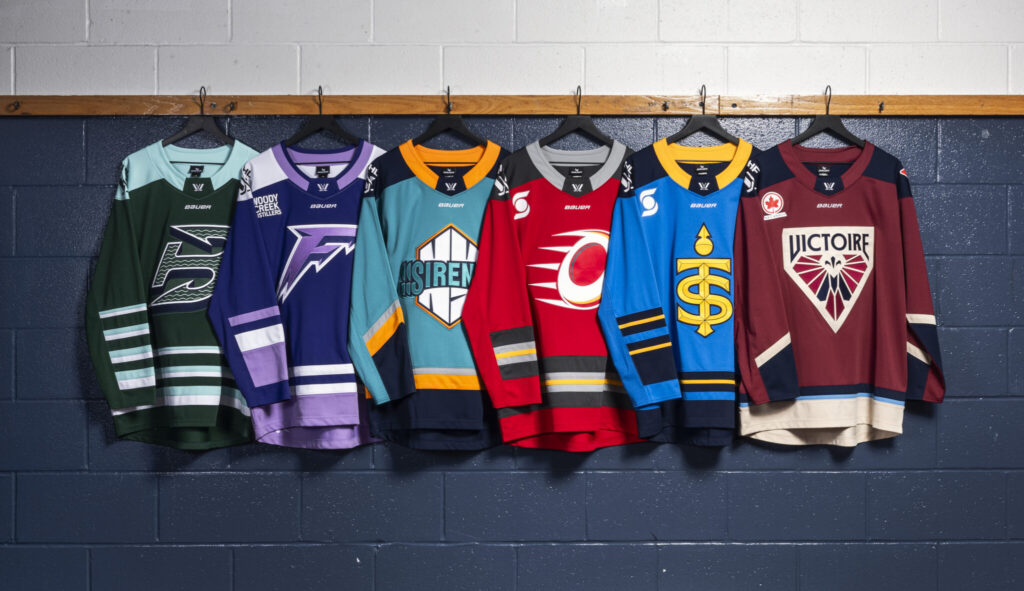
Bauer Hockey takes the lead in PWHL jersey production
"We're proud to be the official game and replica jersey partner for the PWHL, as a next step in our long-standing commitment to girls and women’s hockey," said Mary-Kay Messier, Bauer Hockey's VP of global marketing, in Thursday's PWHL press release. "We are honored to celebrate the players, outfitting them with authentic on-ice jerseys. We are equally excited to celebrate the fans, providing premium-crafted replica jerseys so they can show their passion and support for their favorite PWHL team."
Each team's jersey incorporates elements unique to the club's regional and brand identity. Accordingly, the Minnesota Frost's uniform "embraces the chill" with a deep purple and white motif, "capturing the sharpness of the frozen landscape." Meanwhile, the Boston Fleet's jersey draws on alternating colored stripes, resulting in a "wave-like pattern that evokes a strong connection to the sea."
"Working alongside the team at Bauer, we put thought behind every color, every stitch, every fabric choice — every element— to ensure these uniforms are of the highest quality," added Jayna Hefford, PWHL SVP of hockey operations. "From the design process to final production, we aimed to create uniforms that not only reflect the spirit of each team but also deliver top-tier performance and comfort for our athletes."
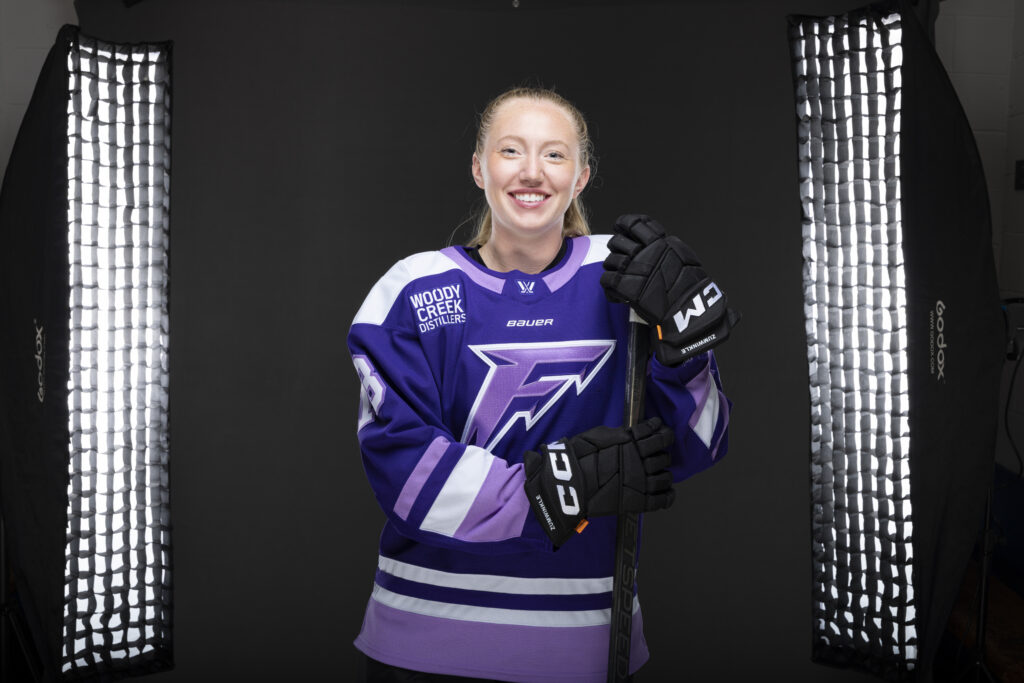
PWHL brings home replica jerseys to fans
"Players and fans alike have been waiting for this moment and we couldn't be happier with the six unique looks each team will don moving forward," said PWHL SVP of business operations Amy Scheer. "These jerseys mark the latest evolution in our league's history, and we can't wait to see them showcased both on the ice and in the stands."
Fans can now purchase home replica jerseys online at the Official PWHL Shop, with key retailers following on November 14th. Replica jerseys will also be available at all home games when the season kicks off on November 30th.
The Professional Women's Hockey League (PWHL) released its expanded 90-game 2024/25 schedule on Tuesday, with the puck dropping on the league's second season on November 30th.
The PWHL's six teams — all featuring fresh branding including new names and logos — will play 30 games each, up from 24 last hockey season.
"Our teams and players are so eager to bring their new identities to life, and the schedule announcement elevates that sense of anticipation," stated Senior VP of Hockey Operations Jayna Hefford in an official league release.
"We have more games, new uniforms, a talented rookie class, and so much more for the PWHL community to look forward to. For our players and our fans, the season ahead will be intense, competitive, and fun."
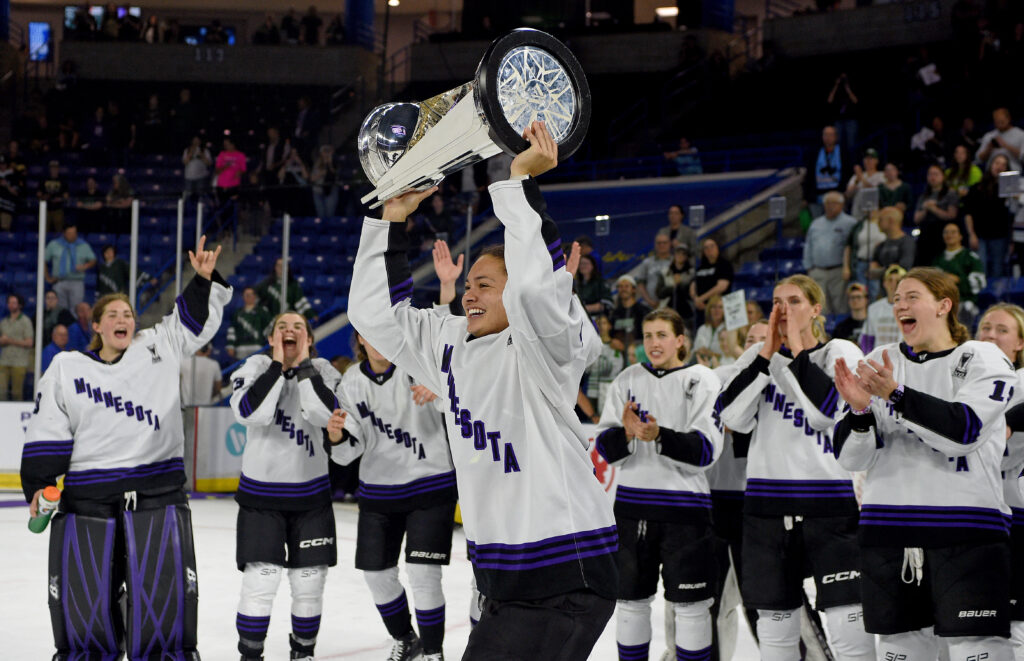
PWHL teams to face each other six times
PWHL teams will play each other six times across the season, with three home and three road matchups on the schedule.
Opening day will see the Boston Fleet visit the Toronto Sceptres at 2 PM ET, with the Montréal Victoire hosting the Ottawa Charge at 5 PM ET. Last year's champions, the Minnesota Frost, will open their 2024/25 title defense at home against the New York Sirens at 6 PM ET on December 1st.
Speaking of the defending Walter Cup Champions, the Frost's second game will be a rematch of last season's deciding Game 5, as Minnesota visits 2023/24 runners-up Boston on December 4th.
PWHL regular season play will run through May 3rd, 2025, with three international breaks on the docket. They start with one-week gaps in December and February for the Women's Euro Hockey Tour and the Canada-USA Rivalry Series, followed by a 22-day pause in April for the 2025 IIHF Women’s World Championship.
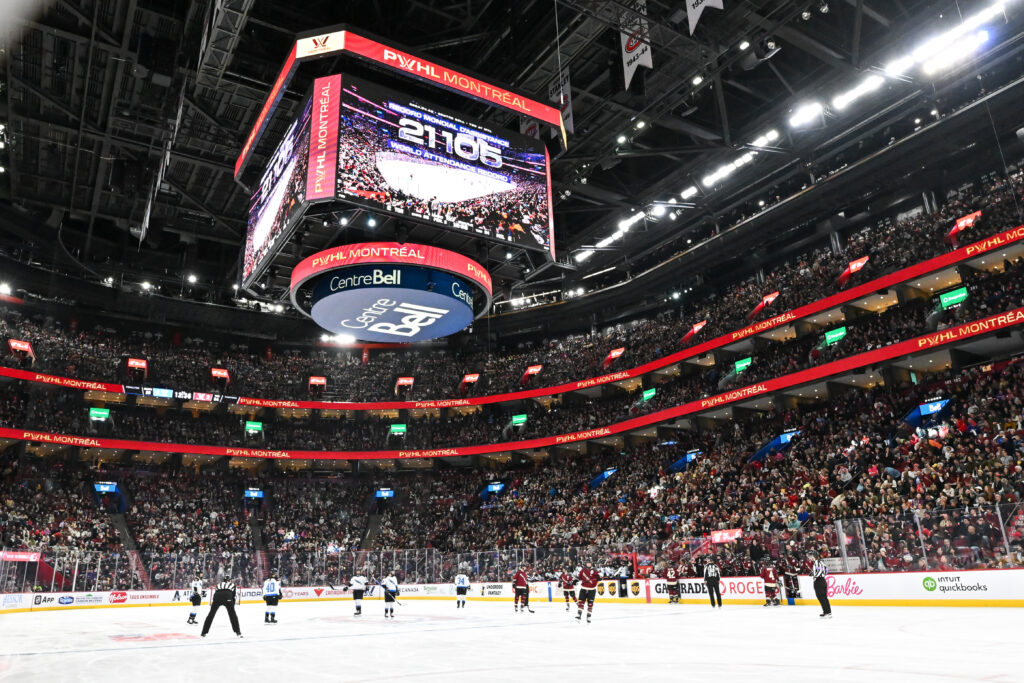
Record-breaking inaugural season shifts some PWHL venues
With the first-year league seemingly breaking attendance records every few days last season, some PWHL teams moved into larger venues during the offseason to accommodate demand.
The Sceptres home ice is now Toronto's Coca-Cola Coliseum, which seats 8,140 fans — more than double the 3,850 capacity of their previous home, the Mattamy Athletic Centre. Toronto already sold out their new arena during last season's playoffs, packing 8,500 into the Coliseum.
Similarly, Quebec's Place Bell will now permanently house the Victoire, increasing Montreal's fan capacity from Verdun Auditorium's 3,795-seats to more than 10,000.
After two successful games at New Jersey's Prudential Center last season, the New York Sirens will call the NHL venue home throughout their 2024/25 campaign.
The newly released schedule also includes 14 games without a listed venue, as the PWHL solidifies plans to stage those tilts at either neutral sites or larger arenas in home markets.
It's a tactic that paid off last season, which saw Toronto and Montreal draw the sport's largest crowd on record when 21,105 packed Montreal's Bell Centre. The league also saw success in drawing hockey fans from non-PWHL cities, including Detroit and Pittsburgh.
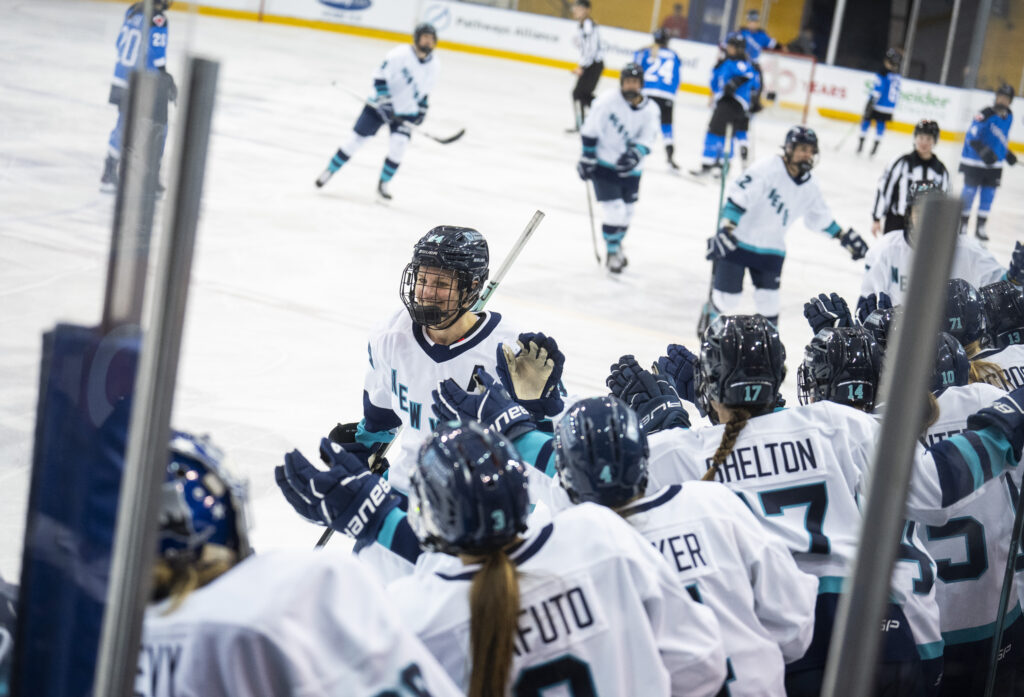
Camps and contract negotiations impact PWHL rosters
While all six teams released their training camps rosters on October 11th, final lists aren't due to the league until November 27th, after training camps and scrimmages.
Each franchise can roster a maximum of 23 players, plus an additional three reserves.
Contract negotiations can continue through the training camp period, with fans most anxiously awaiting news of Princeton University alum Sarah Fillier. The PWHL's 2024 overall No. 1 draft pick remains the league's only first-round selectee still without a signed contract.
While she features on the Sirens's training-camp list, Fillier is reportedly seeking a shorter two-year deal in order to enter negotiations in 2026 — one season earlier than the three-year contract on the table.
2024/25 PWHL season ticket packages now on sale
While the league is still finalizing broadcast details for the upcoming season, fans will be able to buy season ticket packages starting as early as Thursday, October 17th, depending on their local team's roll-out schedule.
Canadian teams are set to release single-game tickets on October 30th, with US franchises dropping theirs on November 1st.
Women's hockey history was made on Wednesday, with PWHL Minnesota taking home the inaugural league championship Walter Cup.
After Boston forced a Game 5 in double-overtime on Sunday, Minnesota went on to notch a decisive victory with a final score of 3-0. Liz Schepers, Michela Cava, and Kendall Coyne Schofield all found the back of the net for Minnesota, with Schofield’s coming on an empty-netter to end the game.
The win came after a disappointing Game 4 loss at home that saw a game-winning — and possibly championship-winning — Minnesota goal waived off. But back in Boston, Minnesota was determined not to leave without that Cup.
"I just think to have something so good taken away, like last game, I just think we knew we had to have it," Taylor Heise, who was named Playoffs MVP after posting a league-leading eight postseason points, told the Athletic. "Like that feeling [of winning] — you had it and you want it back."
The captain and oldest member of the roster, Coyne Schofield had the honors of taking the first lap on the ice with the Walter Cup in hand.
"It makes me want to tear up thinking about it. She's done so much for this sport," Heise said about the captain. "She's definitely one of the people that's helped this sport grow and one of the reasons why this arena is sold out here tonight."
Minnesota goalie Nicole Hensley relayed that Coyne Schofield, who helped to found the PWHL, was more than worthy of the win.
"There’s so much about this day that she deserves," said goalie Nicole Hensley. “She has obviously done so much for this sport and for this professional league. It’s completely fitting that she’s the first one to touch the Walter Cup.”
Perhaps fittingly, Minnesota began the season with a win over Boston and ended it the same way. And yet as they entered the playoffs, the odds were stacked against them,
Minnesota started postseason play as the lowest seed after ending a regular season that saw record-breaking attendance numbers on a five-game losing streak. Then, on the brink of elimination against top-seeded Toronto — who started the first round on a 2-0 series lead — Minnesota won three straight to advance to the Finals.
"It’s honestly hard to put into words," said Coyne Schofield. "As soon as we got in, we never looked back. There were times we were down, but we weren’t out. Some people may have counted us out, but we believed in us, the entire way."
New York won the first-ever PWHL game on Monday, dominating Toronto in a 4-0 win.
It was a historic moment for women’s hockey, with Ella Shelton getting the first goal in PWHL history.
The celly ➡️ the shot pic.twitter.com/0FGtYyzVDJ
— PWHL New York (@PWHL_NewYork) January 1, 2024
It was a monumental day for the new women’s hockey league, with lines for the sellout crowd out the doors and wrapped around the block to get in to watch New York win the first game in PWHL history.
New York followed up with three third-period goals from Alex Carpenter, Jill Saulnier and Kayla Vespa. New York goaltender Corinne Schroeder made 29 saves to get the league’s first shutout.
Billie Jean King, who helped to found the league, was present to witness history and give Toronto their starting lineup.
“Today was one for the history books, as the Professional Women’s Hockey League (@thepwhlofficial) played their 1st game in Toronto,” she wrote on social media. “@PWHL_Toronto took on @PWHL_NewYork, the game was action-packed, & the arena was full of terrific fans.”
Today was one for the history books, as the Professional Women's Hockey League (@thepwhlofficial) played their 1st game in Toronto. @PWHL_Toronto took on @PWHL_NewYork, the game was action-packed, & the arena was full of terrific fans.
— Billie Jean King (@BillieJeanKing) January 2, 2024
Join me in supporting these athletes! https://t.co/QxCeQlPgNf
Last Thursday, PHF players and staff learned that assets of their league had been acquired by the Mark Walter Group ahead of the launch of a new professional women’s hockey league in January 2024. While the PHF portrayed the news as good for the future of women’s hockey, players — whose contracts for the upcoming season are now void — understandably had some questions.
“I think people are having a lot of different, conflicting feelings simultaneously. I think there’s some shock, some anger, some sadness, as well as some hope and optimism and excitement,” PHF Players’ Association (PHFPA) executive director Nicole Corriero told Just Women’s Sports in a phone interview.
Corriero, who got a heads up about the sale from commissioner Reagan Carey last Tuesday, said the players’ association has had internal discussions since the announcement about how to best support players during the transition period.
“The drastic changes that people are going to be having to make in terms of their lifestyle, financial decisions, things like that — along with the uncertainty that’s coupled with it — is really daunting and really challenging,” she said.
Corriero, a former three-time NCAA All-American at Harvard, has led the PHFPA for just over a year. She said the players’ association is committed to ensuring that anyone affected by the sale has an outlet for communication.
“I would say my biggest concerns are the people who were new signees, whether they’re coming out of college or people that are coming overseas,” Corriero said.
“It’s understandable that not everybody is going to get their pom-poms out and be excited, even if there is a lot of positivity, a lot of hope and a lot of optimism for the future.”
While the PHF Players’ Association has not posted anything on its social media channels, on Sunday a group of 11 PHF players representing all seven teams issued a public statement that expressed a message of optimism entering this new era of women’s hockey.
“We are hugely excited to see a unified league that will house all of the best athletes that hockey has to offer and aim to build the strongest league that can stand the test of time,” they wrote.
The players who signed the letter — Jillian Dempsey, Allie Thunstrom, Dominique Kremer, Kacey Bellamy, Kennedy Marchment, Madison Packer, Kaleigh Fratkin, Katerina Mrazova, Sydney Brodt, Ann-Sophie Bettez and Shiann Darkangelo — are among the PHF/NWHL’s most senior veterans.
They are also among the league’s most talented players; 10 of the 11 were named All-Stars in 2023 and all are expected to contend for a spot in the new league. The only non All-Star in the group, Kacey Bellamy, served as PHF scout and player liaison during the 2022-23 season. In April, she announced she was coming out of retirement to sign with the Connecticut Whale.
While some members of the player leadership committee also serve as players’ association representatives, the two groups are separate.
According to Corriero, the players in the leadership committee are “players that the now dissolved league contacted or communicated with to discuss some of the initial news because they can be an initial support system.”
Corriero added: “The leadership committee is not intended to replace the Players’ Association. It has a somewhat different objective in terms of what it’s trying to promote and help to communicate on behalf of the players. It is a separate entity in that it was kind of created in conjunction with the league as a conduit for communication and helping with the transition.”
In a message reviewed by Just Women’s Sports, the player leadership committee asks players to forward any media inquiries or communications regarding the PWHPA, PHF or the new league to a committee email address “until further notice” to ensure “PHF players are unified and consistent with our message across all communication channels.”
Asked how this committee’s goals and mission differ from those of the players’ association, Fratkin wrote: “The Player Leadership Committee and the PHFPA are complementary resources for players who played in the PHF. This is not a faction with separate goals. Our purpose is to be an added liaison for players during this transition.”
The player leadership committee did not respond to a question about how its members were selected. The league also did not immediately respond to a request for comment regarding its role in assembling and/or selecting members for the player leadership committee.
Members of the Professional Women’s Hockey Players Association (PWHPA) ratified their collective bargaining agreement via a unanimous vote Sunday night after a 72-hour voting window.
The new CBA also comes on the heels of the confirmation of a new women’s professional hockey league, which is slated to launch in January 2024 with financial and leadership support from the Mark Walter Group and Billie Jean King Enterprises.
The union, dubbed the Professional Women’s Hockey League Players Association (PWHLPA), was voluntarily recognized by its new employer, though the league itself is yet to be named. It is the first union in North American women’s pro sports — and possibly all of pro sports — to have a ratified CBA prior to the start of competition. The WNBA ratified its first CBA in 1999 ahead of the league’s third season, while the NWSL’s first CBA was finalized in 2022 ahead of the league’s 10th season.
The PWHPA’s bargaining committee — consisting of Kendall Coyne Schofield, Brianne Jenner, Hilary Knight, Liz Knox and Sarah Nurse — negotiated with the league’s new owners for five months. They kept PWHPA players up-to-date on the negotiation process until the final CBA was proposed on Thursday night.
The new women’s hockey CBA outlines salary and facility requirements and guarantees benefits and standards for health insurance, housing stipends, a 401(k) program, relocation expenses, per diems, hotel accommodations, pregnancy benefits, childcare coverage, parental leave, nursing accommodations and more.
Hailey Salvian of The Athletic reported that salaries will range from $35,000 to $80,000 or more during the initial year of competition, with minimum salaries set to increase by 3% each year. Salvian also reported that the CBA includes stipulations that no more than nine players can be paid the league minimum and that, during year one, at least six players per team will be signed to three-year $80,000-plus guaranteed contracts.
According to a source who reviewed the document, there isn’t a traditional salary cap. Instead, the CBA is structured on salary averages to ensure that the divide between lowest and highest paid players doesn’t grow too large.
“It sets us up with this foundation and expectations. Players know what they’re going to get,” PWHPA operations consultant Jayna Hefford told Just Women’s Sports.
“There are player protections and workplace safety (requirements). There are standards that are going to have to be met as it relates to facilities and where players train. All of that is critical to the success of a long term, viable league.”
Stan Kasten, a member of the league’s new board who was part of the negotiating process, praised the players involved.
“I can’t say enough about the determination of this group of PWHPA players. They fought for what they believe, they were determined, passionate and really, really smart,” Kasten told Just Women’s Sports.
“They held out until they got the rights, the protections, the facilities – all of those things that elite athletes deserve. And they didn’t settle for second best, they waited. And they wound up with something that is kind of a dream come true for all of us involved in this.”
When the PWHPA filed its articles of incorporation in 2019 following the collapse of the CWHL, as players looked for more than what the PHF (then NWHL) could guarantee, the group cited sustainability as one of its goals.
“We are prepared to stop playing for a year—which is crushing to even think about—because we know how important a sustainable league will be to the future of women’s sports,” Shannon Szabados, a two-time Olympic gold medalist for Canada, said at the time.
It ultimately took four years, not one, but Kasten said the new ownership group is in it for the long haul.
“We have not just a long-term vision, but a permanent vision, and that requires funding,” he said. “It requires infrastructure. And, most of all, it requires strength of ownership and leadership. And we’re starting with Mark Walter and Billie Jean King and, I’m sorry, it doesn’t get better than that.”
There is a long history of women’s sports leagues — including women’s hockey leagues — launching without proper funding, infrastructure, or safety measures in place. That was even one of the factors Sally Yates cited in the U.S. Soccer-commissioned report into abuse in the NWSL.
“In the haste to get the League off the ground, the Federation conducted limited financial due diligence on the new league’s prospective owners and did not put in place the infrastructure or planning necessary to support the League over the long haul. Instead, the focus was on putting eight teams on the field,” the Yates report read.
The new hockey league is looking to avoid such pitfalls.
“Fans maybe don’t understand why (a CBA) is so important, but when we look at those other leagues, when we look at what’s happened in women’s hockey, a lot of those difficult things that have happened were because there weren’t player protections and workplace safety and termination clauses,” Hefford said.
While current PWHPA members negotiated and voted on the CBA, former PHF members will be eligible to join the PWHLPA union.
Members of the U.S. women’s hockey team make less money than their Canadian rivals.
Canadian players not only have access to a larger pool of funds, but Hockey Canada is providing funding for five developmental players in addition to funding its 23-player roster, the Associated Press reported Thursday. In comparison, USA Hockey limits its funding to 23 players.
The report comes after a long battle between American players and USA Hockey over the benefits and provisions in their new contract.
A source familiar with the negotiation process told Just Women’s Sports that U.S. players tried to get similar developmental funding, but USA Hockey refused to cover the expense. The source spoke on the condition of anonymity due to a confidentiality clause in the U.S. contract.
In addition, Canadian players receive a percentage of ticket revenue from the annual Rivalry Series games played in Canada. There’s no comparable revenue sharing agreement in the U.S. contract.
The NHL is providing some funding to U.S. players as part of the new deal, something the league initially began doing following the 2017 boycott, per the AP report. For reference, the NHL has given USA Hockey money for the boys-only national team developmental program (NTDP) for decades.
Canada’s contract, which lasts just one year, went into effect on Oct. 1, 2022, and was announced in December. The U.S. contract, which lasts for three years, was never announced but was signed in January. The old U.S. contract was initially set to expire in August 2022 — right in the middle of the 2022 World Championship — but the two sides agreed to an extension ahead of the competition.
U.S. players have long been critical of USA Hockey’s treatment and promotion of the women’s team, in addition to the resources and funding provided to the country’s female athletes. In 2017, U.S. players threatened to boycott that year’s World Championship unless USA Hockey came to the table and provided the women’s team with more equitable funding and support. According to the AP, while the pool of money allocated to U.S. players has increased since 2017, it has not kept up with the pace of inflation.
Both Hockey Canada and USA Hockey consider players independent contractors, not employees. As a result, players are unable to collectively bargain or unionize. That’s a major difference from the soccer world, where both the U.S. and Canadian teams are unionized. Canada’s national soccer team is currently embroiled in a dispute with Canada Soccer over its own collective bargaining agreement.
Team USA won the 2023 IIHF Women’s World Championship title on Sunday night in a thrilling come-from-behind victory. The U.S. defeated Canada, 6-3, at the CAA Centre in Brampton, Ontario, to win its 10th women’s hockey world title — and first since 2019.
The final score was not indicative of just how tight the game was. Canada led three times on Sunday night, with the U.S. coming back each time.
Tied 3-3 with just over three minutes remaining in regulation, U.S. captain Hilary Knight scored the go-ahead goal on a 5-on-3 power play — her 100th career world championship point. Knight, who also scored Team USA’s second goal of the night, completed her hat trick just 27 seconds later.
Let's look at that @HilaryKnight game-winning goal one more time! #WomensWorlds pic.twitter.com/mEHeqKnu4J
— USA Hockey (@usahockey) April 17, 2023
Why stop at 100? Knight gets #101 less than a minute later!@HilaryKnight | #WomensWorlds pic.twitter.com/EY10NZ1DxS
— USA Hockey (@usahockey) April 17, 2023
Aerin Frankel anchored the U.S. in net, turning away 24 shots.
Canada entered the final with momentum in the cross-border rivalry, having won the last two world championship titles, plus Olympic gold in 2022. Then add in that Canada was on a five-game win streak versus the U.S., which included a nine-round shootout victory during the preliminary round.
For the 22nd time in 22 tournaments, the U.S. women’s hockey team will play in the final of the IIHF Women’s World Championship.
The U.S. defeated Czechia, 9-1, at CAA Centre in Brampton, Ontario, on Saturday to book a spot in this year’s championship game (Sunday 7pm ET, NHL Network). Team USA will play the winner of Saturday’s other semifinal (Canada vs. Switzerland).
The U.S. kicked off scoring into the first period with an Amanda Kessel power play goal (video embedded below).
Kessel putting the POWER in power play! 👊@AmandaKessel28 | #WomensWorlds pic.twitter.com/z3RQRupxyZ
— USA Hockey (@usahockey) April 15, 2023
While Kessel’s was the only goal scored in the first period, the U.S. opened the floodgates in the second with two goals from Hilary Knight, one from Abbey Murphy, one from Abby Roque, and another from Kessel.
Czechia also recorded its lone goal of the game the second period with this snipe from 16-year-old Adéla Šapovalivová, who is making her second senior world championship appearance in Brampton (video embedded below).
Adela Sapovalivova puts Czechia on the board!#WomensWorlds pic.twitter.com/Zks7jBomye
— TSN (@TSN_Sports) April 15, 2023
With the win, the U.S. women’s hockey team continues its unprecedented streak of World Championship finals appearances. Beginning with the first IIHF Women’s World Championship in 1990, the U.S. has qualified for the final each and every time, winning the world title on nine occasions.
Archrival Canada has made the world championship final every year save one: 2019, when the Canadians were upset by Finland, 4-2, in the semifinal round.
Women’s Hockey World Championship – Year-by-Year Finals History
- 1990: Canada def. United States, 5–2
- 1992: Canada def. United States, 8–0
- 1994: Canada def. United States, 6–3
- 1997: Canada def. United States, 4–3 (OT)
- 1999: Canada def. United States, 3–1
- 2000: Canada def. United States, 3–2 (OT)
- 2001: Canada def. United States, 3–2
- 2003: Tournament cancelled due to SARS outbreak
- 2004: Canada def. United States, 2–0
- 2005: United States def. Canada, 1–0 (SO)
- 2007: Canada def. United States, 5–1
- 2008: United States def. Canada, 4–3
- 2009: United States def. Canada, 4–1
- 2011: United States def. Canada, 3–2 (OT)
- 2012: Canada def. United States, 5–4 (OT)
- 2013: United States def. Canada, 3–2
- 2015: United States def. Canada, 7–5
- 2016: United States def. Canada, 1–0 (OT)
- 2017: United States def. Canada, 3–2 (OT)
- 2019: United States def. Finland, 2–1 (SO)
- 2020: Tournament cancelled due to COVID-19
- 2021: Canada def. United States, 3–2 (OT)
- 2022: Canada def. United States 2–1
After an up-and-down regular season, the Wisconsin Badgers put on a postseason clinic, winning the 2023 NCAA women’s hockey national championship on Sunday. With the win, the Badgers broke their tie with the University of Minnesota for most NCAA titles in women’s hockey (7).
Wisconsin defeated defending national champion Ohio State, 1-0, at AMSOIL Arena in Duluth, Minnesota. Badgers first year Kirsten Simms scored the lone goal of the game, 13 minutes into the first period. It marks the first time Ohio State’s women’s hockey team was shutout in over a year.
WHO ELSE BUT KIRSTEN SIMMS?! BADGERS ARE ON THE BOARD.
— NCAA Ice Hockey (@NCAAIceHockey) March 19, 2023
📺 ESPNU #WFrozenFour x @BadgerWHockey pic.twitter.com/VBNYcJGleE
Despite the program’s historic success, Wisconsin didn’t enter this year’s NCAA tournament as the favorite. The Badgers had a rough start to 2023, dropping five straight games in January (including two to Ohio State). After losing to Minnesota in the WCHA Championship earlier this month, Wisconsin got an at-large bid to the NCAA tournament as the No. 6 seed. They went on to defeat No. 3 Colgate in the quarterfinals, No. 2 Minnesota in the semifinals (winning with a thrilling OT goal), and then met No. 1 Ohio State in the championship game.
All seven of Wisconsin’s women’s hockey NCAA titles (2006, 2007, 2009, 2011, 2019, 2021, 2023) have been won under longtime Badgers head coach Mark Johnson.